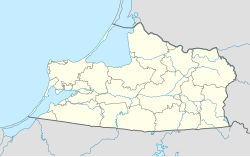Yasnaya Polyana, Kaliningrad Oblast
This article includes a list of references, related reading, or external links, but its sources remain unclear because it lacks inline citations. (January 2013) |
Yasnaya Polyana
Я́сная Поля́на | |
|---|---|
 Yasnaya Polyana park | |
| Coordinates: 54°34′07″N 22°26′46″E / 54.56861°N 22.44611°E | |
| Country | Russia |
| Federal subject | Kaliningrad Oblast |
| Administrative district | Nesterovsky District |
| Elevation | 77 m (253 ft) |
| Population | |
• Total | 997 |
| Time zone | UTC+2 (MSK–1 |
| Postal code(s)[3] | |
| OKTMO ID | 27624402176 |
Yasnaya Polyana (Russian: Я́сная Поля́на; German: Trakehnen, from 1929 Groß Trakehnen; Lithuanian: Trakėnai; Polish: Trakeny[4]) is a rural settlement (posyolok) in the Nesterovsky District of Kaliningrad Oblast, Russia. It is located in the southeast of the oblast, north of the Romincka Forest. Nearby Diwnoje Nowoje is a railway station on the former Prussian Eastern Railway from Kaliningrad to Kybartai in Lithuania.
History
[edit]The settlement was originally named after the Old Prussian word trakis, meaning "great bog". It was known as Trakėnai in Lithuanian, Trakeny in Polish, and Trakehnen in German. In 1454, King Casimir IV Jagiellon incorporated the region to the Kingdom of Poland upon the request of the anti-Teutonic Prussian Confederation.[5] After the subsequent Thirteen Years' War (1454–1466), it became a part of Poland as a fief held by the Teutonic Knights.[6]
From the 18th century it formed part of the Kingdom of Prussia. In 1731 King Frederick William I of Prussia had the swampy territory of the Pissa River drained to establish the famous warmblood Trakehner horse breed stable (Königliches Stutamt Trakehnen) northwest of the municipality. The area was colonized by Protestant expellees from the Archbishopric of Salzburg.

Intended for the build-up of an own breeding supplying the Prussian Army cavalry, the stud farm at the time of its opening in 1732 had about 1,100 horses standing on an area of 25 km2 (9.7 sq mi). The "Soldier King" however soon became dissatisfied with the poor efficiency of the stud farm and in 1739 granted it to his son, crown prince Frederick II of Prussia. Upon Frederick's death in 1786, it was taken over by the Prussian state and renamed Königlich Preußisches Hauptgestüt Trakehnen. In professional hands, the stud and the village of Trakehnen prospered from that time on.
The Trakehnen stud farm had to be evacuated after the Prussian defeat at the 1806 Battle of Jena-Auerstedt, when the French Grande Armée approached to meet the Russian forces at the Eylau. From 1871, it was part of Germany, within which it was administratively located in the Stallupönen district in the Regierungsbezirk Gumbinnen in the province of East Prussia. From 1911 on it was the site of an annual cross-country race, named in the memory of Colmar von der Goltz in 1931.
After the Red Army had occupied the settlement at the end of World War II, it passed to the Soviet Union and was renamed to Yasnaya Polyana ("clear glade"). Although the settlement received a new name, the Russian name has a similar reference to the land, as Polje means "field" or "glade". The land was off-limits to all people outside of the Soviet Union for fifty years and information about it was almost non-existent. After the fall of the Iron Curtain, a few ethnic Germans from Russia and Kazakhstan were resettled to Yasnaya Polyana.
It was not maintained as a stable, although the grounds do have a museum for the breed. Russian and German initiatives have brought Trakehner horses to nearby Pravdinsk and Mayovka.
Notable people
[edit]- Gustav von Below (1791–1852), Prussian general
- Walther Funk (1890–1960), Nazi politician
- Heinz Ziegler (1894–1972), Wehrmacht general
- Leo Tolstoy (1828-1910), Writer
See also
[edit]References
[edit]- ^ Russian Federal State Statistics Service (2011). Всероссийская перепись населения 2010 года. Том 1 [2010 All-Russian Population Census, vol. 1]. Всероссийская перепись населения 2010 года [2010 All-Russia Population Census] (in Russian). Federal State Statistics Service.
- ^ "Об исчислении времени". Официальный интернет-портал правовой информации (in Russian). 3 June 2011. Retrieved 19 January 2019.
- ^ Почта России. Информационно-вычислительный центр ОАСУ РПО. (Russian Post). Поиск объектов почтовой связи (Postal Objects Search) (in Russian)
- ^ Słownik geograficzny Królestwa Polskiego i innych krajów słowiańskich, Tom XII (in Polish). Warszawa. 1892. p. 443.
{{cite book}}: CS1 maint: location missing publisher (link) - ^ Górski, Karol (1949). Związek Pruski i poddanie się Prus Polsce: zbiór tekstów źródłowych (in Polish). Poznań: Instytut Zachodni. p. 54.
- ^ Górski, pp. 96–97, 214–215
External links
[edit]- Pictures of the Trakehner stables
- Trakehners in former East Prussia
- History of the Trakehner horse breed




